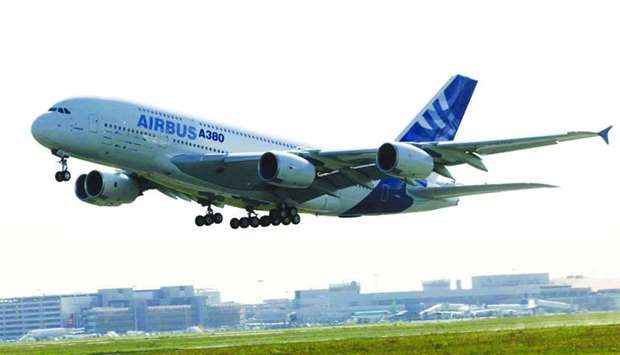*As many as 3,500 jobs affected by the decision
Airbus SE decided to stop making the A380 double-decker after a dozen years in service, burying a prestige project that won the hearts of passengers and politicians but never the broad support of airlines that instead preferred smaller, more fuel-efficient aircraft.
Production of the jumbo jet will end by 2021, after the A380’s biggest customer, Emirates, and a handful of remaining buyers receive their last orders. The Gulf carrier will pare down its current A380 order to 14 from 53.
“Today’s announcement is painful for us and the A380 communities worldwide” Airbus chief executive office Tom Enders said in a statement. Airbus said as many as 3,500 jobs are affected by the decision.
While the A380 has struggled for years to match its popular appeal with a robust order book, the radical move to cancel the plane outright marks a watershed moment for civil aviation. The A380 was always more than an aircraft, albeit a very large one. Rather, it was the manifestation of Europe’s collaborative drive and the continent’s industrial ambitions.
For Airbus, the airliner sought to create a commanding counterweight to Boeing Co, promising unparalleled space and luxury for increasingly congested airports and the skies above.
But from early on, the world’s largest commercial passenger plane with capacity for more than 800 passengers had a hard time, both technically and commercially. Getting the A380 airborne for its maiden flight was severely delayed by wiring glitches that resulted from faulty communications between design teams. When the plane finally embarked on its first commercial flight in late 2007, the financial crisis that would cripple global travel was already on the horizon. Some customers had second thoughts about whether the giant aircraft was the right choice for meagre times, and cancellations started piling up.
Airbus had watched enviously as Boeing monopolized the market for very large aircraft with its 747 jumbo, which celebrates its 50th anniversary this month and sold more than 1,500 units. While Airbus was a major force in the single-aisle space with its A320 family, the prestigious long-distance and ultra-large aircraft segment remained the domain of its US rival. With passenger numbers rising every year and major new hubs opening in markets like Dubai, the A380 seemed the obvious choice to address the need for a large people carrier, while picking market share off Boeing.
Dubai turned into the A380s major sponsor, with Emirates ordering a total of more than 160 units, far in excess of any other airline. But it was also Emirates that contributed to the A380’s decline and fall. With Airbus increasingly reliant on a single customer for its flagship product, Emirates could make or break the programme by ordering or cancelling more A380s. When the airline decided to rethink latest order for 20 units, Airbus saw no choice but to draw down production, given the lack of other buyers.
“As a result of this decision we have no substantial A380 backlog and hence no basis to sustain production, despite all our sales efforts with other airlines in recent years,” Enders said.
From its inception, the A380 was a grand European project. The wings, like those of all Airbus aircraft, came from the UK, components were ferried across the continent from production sites in Germany and France. The giant fuselage tubes were taken by barge and flat-bed truck to the main facility in Toulouse, and the planes were then painted and kitted out in Hamburg. Teams from across the region joined colleagues at other sites during crunch times, the quirky-looking Beluga freight planes would crisscross countries with parts, and the A380 was a popular backdrop at air shows for politicians celebrating Europe’s achievements.
But over the past two decades, a new breed of aircraft gained popularity, making life harder for the A380 and the Boeing 747, which has also struggled with the latest passenger version of its iconic hump-backed plane. While the A380 represented an Airbus bet on congestion driving demand for ever-larger aircraft in mega-hub airports, Boeing in the early 2000s decided the future would lie in smaller long-range planes that could economically overfly the hubs and directly connect smaller markets.
Markets where Airbus had hoped to sell its prestige plane hardly caught on or didn’t materialize at all. There isn’t a single US carrier that uses the A380, Chinese airlines have only bought the model in low numbers, and Japan - traditionally a big buyer of the Boeing 747 - has only recently taken delivery of its first A380.

